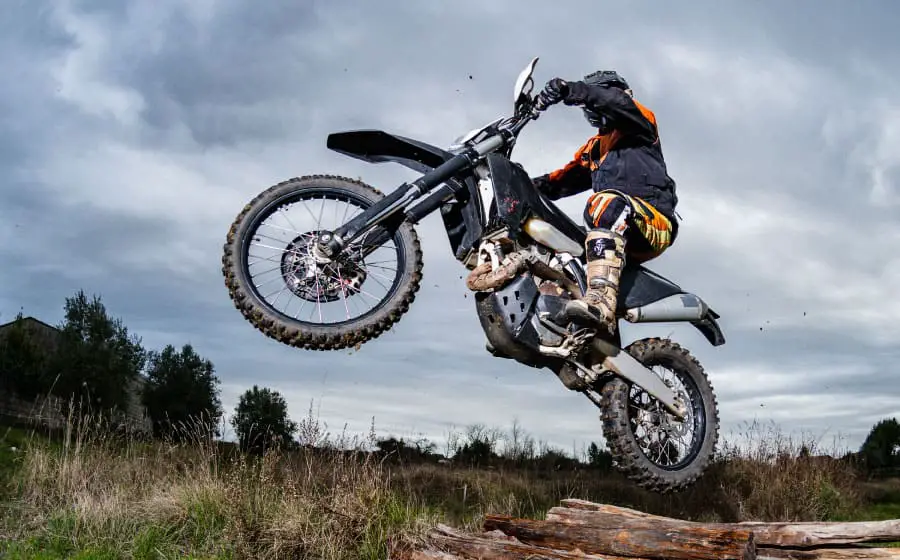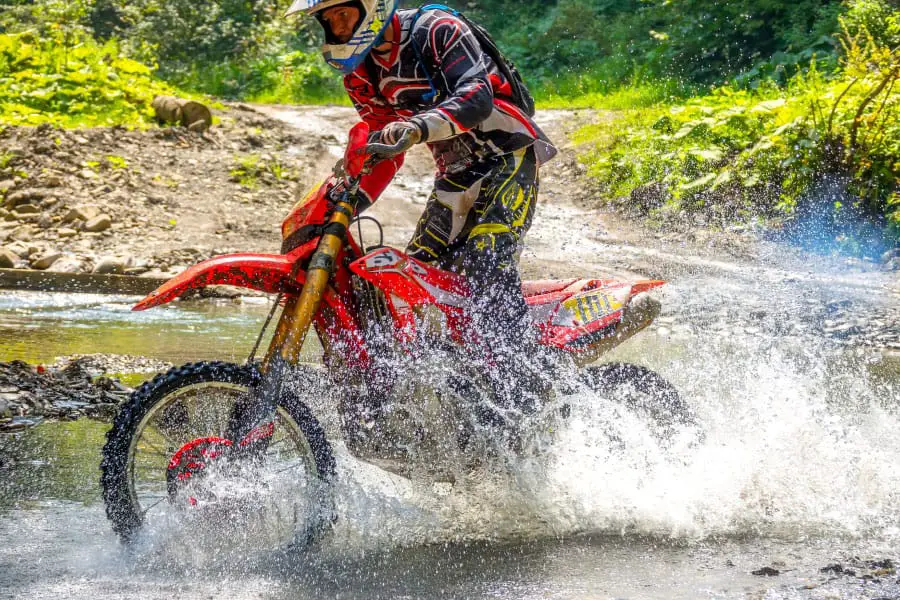
Many people who get on an enduro bike for the first time are often surprised at how tall they are! Usually, they are so tall that when sitting comfortably on the seat, only your toes touch the ground. Is there a reason that these bikes are taller than other bikes, and what has led to this development in their design?
There are several aspects of enduro bike riding that have contributed to their tall design, compared to other bikes, like the terrain they are used on, their power requirements, suspension, tire requirements, and riding position.
The excessive height of enduro bikes and some MX bikes have been a point that has elicited much discussion among riders of these bikes and people who are interested in getting into riding these bikes but have concerns about the height. You will find a similar thread on most off-road bike forums where this issue receives substantial coverage.
Due to the topic being one that is raised pretty often, we thought to address it here too to give our readers some input on the matter and possibly some guidance to quell their concerns or offer some alternatives.
The Terrain Enduro Bikes Are Used On
Enduro bikes, being machines designed for rough off-road riding, requires the manufacturers to take into account the taxing demands that this kind of terrain has on both rider and machine. These unique operating conditions require adjustments to be made in the design to cater for the demands. The design specs need to enable the bike to be competitive and capable of competently traversing this environment and give the rider a certain level of ease, comfort, and easy handling.
The type of terrain these bikes are used on has led to or at least played some part in most of the design differences of these bikes. The two major factors that the terrain has influenced are ground clearance and suspension requirements for the enduro bike.
Ground clearance is an important factor when the terrain is uneven, and many obstacles can be encountered which rider and bike need to negotiate. Ground-clearance will give the bike the ability to ride on areas with large boulders, ground with humps and corrugations without the concern that these obstacles will cause damage to the underside of the bike and motor.
The suspension is a critical design factor to make these bikes durable on the terrain they travel and to provide shock absorption for both the protection of the bike and rider! The bumps and humps of this type of ground require that enduro bikes have a large travel suspension. This means the suspension needs to be built to have a significant amount of movement before it bottoms out.
When the suspension bottoms out on a bike, it makes for a bone-jarring, uncomfortable ride for the rider, and the constant shock causes damage to the suspension itself and other components of the bike.
To prevent this from occurring on an off-road bike, the suspension needs to be able to travel further before it bottoms out. This requires the suspension to be longer than those on other bikes, which contributes to the overall height of the bike.
Riding Position
The aspect of riding position is one that is fairly closely related to the type of terrain that enduro bikes are used in. Rough ground is often more comfortable for the rider to traverse in a standing position rather than in a sitting position, as is common with most other bikes.
The standing position gives the rider the ability to see over obstacles and adjust for what is on the other side. The position allows the knees to act as shock absorbers for the rider as well to reduce some of the bouncing around caused by the uneven ground.
If you have ever tried to ride in a standing position on a bike that is not designed for it, you will know how uncomfortable that feels. The handlebars are low and further away, and the bike feels less controllable. Enduro bikes have been designed to accommodate the standing riding position and make it feel comfortable and keep the feeling of being in comfortable control of the bike.
This design increases the distance between the seat and the footpegs and influences the height of the handlebars. This, in conjunction with the additional height requirements of the suspension, makes for an overall taller bike.

Enduro Bike Power Requirements
Enduro bikes usually have larger engines than other off-road bikes. The bigger engines are necessary due to the wider range of terrain that enduro bikes are used in and their need for higher speeds on flatter terrain. These larger engines require more space in the frame to accommodate their size.
Making the engines wider is not practical if you want a bike that is maneuverable in rough terrain. The only other option is to have taller engines. The components of the engines are arranged in a more vertical configuration rather than horizontal.
Enduro Bike Tire Requirements
A resulting factor of the varied environments that these bikes need to be able to handle is that their wheels and tires are usually of a larger diameter than many other off-road bikes.
Enduro bikes are designed for cross-country type riding, which requires them to have the capacity and capability to traverse deep mud, thick sand, and even deep water crossings. In order to handle these types of off-road obstacles with sufficient clearance to stop the bike from becoming bogged down in sand or mud or deep water causing damage to the engine, a larger diameter wheel becomes an important design consideration.
Of course, the bigger diameter of the wheel adds height to the bike, but it cannot be compromised without affecting the performance of the enduro bike in these conditions.
Manufacturing Logistics
Manufacturers find it more logical and better logistically to produce bikes for bigger riders than smaller riders. It is easier to adjust a bike made for a tall rider to suit a shorter rider than it is to make adjustments to a short bike for a taller person! For this reason, most enduro bikes are manufactured with a taller person n mind.
The average rider height that most manufacturers aim for is 5 foot 9 inches. If you are taller than this, you won’t have a problem with these bikes, but shorter riders find it to be a significant frustration. This is particularly the case when a larger engine capacity bike is required, but the additional height this adds to the bike puts it out of the range of the shorter rider.
Most manufacturers try their best to build in some height adjustment capability on their machines, the range that these can be adjusted to is limited. If you think you can purchase a bike made for a 5ft 9′ rider and adjust it to your 5ft 4′ height, it is just not going to happen!
How To Lower An Enduro Bike
If you find that your enduro bike is a little on the high side for your stature, there are a couple of things you can try to shave a few inches off the height of your bike. If the amount you need to reduce the height of your bike is only an inch or two, then these tips may be enough for you, but they are limited in how far they can reduce the height of your bike.
Reduce the seat height. Reducing the seat height is probably the cheapest and easiest method to shave some height from your bike. Remove the seat and carefully take off the outer cover to expose the foam underneath. Trim some foam from the top of the seat, and depending on the seat, you may be able to trim between an inch and an inch and a half from the foam. Replace the outer cover and re-fit the seat to the bike. Many riders find that this simple method gains enough of a height reduction to make them comfortable.
Install lowering links. Lowering links are a bolt-on aftermarket product that replaces the shock linkage on the bike and can lower the height of the bike by about one inch. The downside of installing lowering links is that it does lower the ground clearance of your bike, and it reduces the travel of the suspension.
Conclusion
The fact that enduro bikes are tall comes down a necessity due to their purpose. The difficulties involved in adjusting the height of these bikes to a smaller rider are significant. The outcome may be that the wiser decision is to buy a smaller bike that fits the rider more comfortably, even if that means going for a smaller bike with a smaller engine.
Feel free to check out our article on “This Is Why Enduro Bikes Are So Expensive.”


